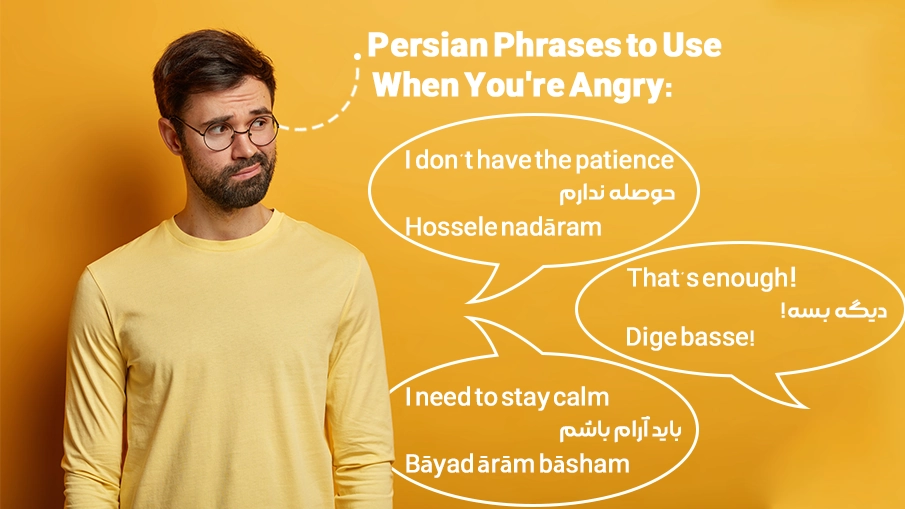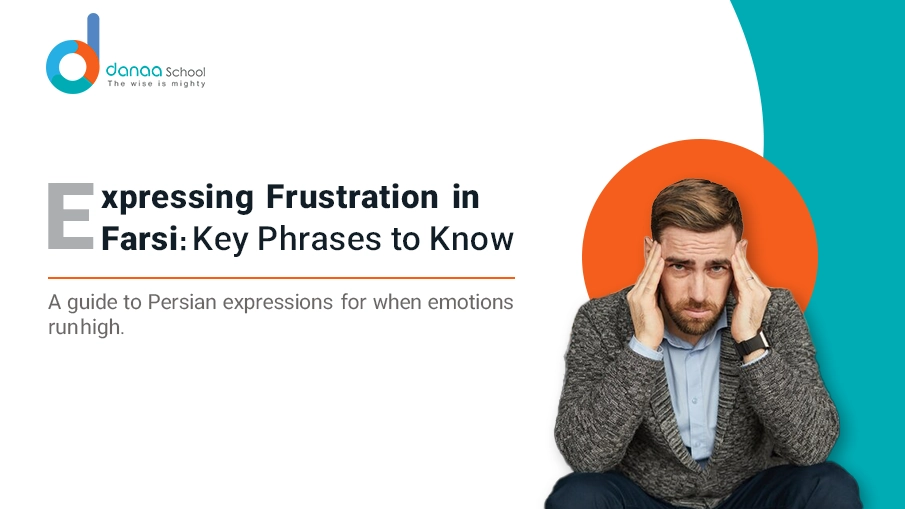Anger is a universal emotion, but its expression varies across cultures and languages. Persian (Farsi), known for its poetic and nuanced style, offers many phrases to express feelings.
Whether navigating a disagreement, articulating frustration, or emphasizing a point, learning how to convey anger in Persian can make your communication more effective and culturally appropriate.
This guide explores essential Persian phrases to use when you’re angry, from mild annoyance to intense frustration, along with idioms, cultural insights, and tips to manage tone and delivery.
Why Learn Persian Phrases for Expressing Anger?
Language is more than words; it’s a gateway to understanding culture. In Persian, emotions are often conveyed with subtleties that reflect the culture’s emphasis on politeness and respect. Mastering these expressions allows you to:
-
- Navigate emotional situations confidently.
-
- Deepen connections with Persian speakers.
-
- Avoid misunderstandings by using context-appropriate language.
Understanding Persian phrases for anger isn’t just about learning Persian words; it’s about appreciating a linguistic tradition that blends emotion with eloquence.
How to Say I’m Angry in Persian
- The most basic way to say “I’m angry” in Persian is:
من عصبانی هستم (Man asabāni hastam) – I’m angry.
- For an informal tone, you can say:
عصبانیام (Asabāni-am) – I’m angry.
These phrases are essential building blocks, but Persian offers far more colorful ways to express varying degrees of anger.
Persian Phrases to Use When You’re Angry
Sometimes, anger is mild and doesn’t require strong words. Here are common phrases for such situations:

-
- حوصله ندارم (Hossele nadāram) – I don’t have the patience.
-
- دیگه بسه! (Dige basse!) – That’s enough!
-
- باید آرام باشم (Bāyad ārām bāsham) – I need to stay calm.
These phrases are helpful when you’re annoyed but don’t want to escalate the situation.
Commonly Used Expressions to Express for Annoyance
When expressing disapproval, Persian speakers often use direct yet polite phrases:
-
- این کار درست نیست (In kār dorost nist) – This is not right.
-
- چرا این کارو کردی؟ (Cherā in kāro kardi?) – Why did you do this?
-
- این قابل قبول نیست (In ghābele ghabool nist) – This is unacceptable.
These phrases allow you to express dissatisfaction without coming across as overly harsh.
Persian Idioms to Convey Anger
Idioms are integral to Persian, adding depth and flair to conversations. Here are some idiomatic expressions for anger:
-
- خونم به جوش اومده (Khoonam be jush umade) – My blood is boiling.
-
- اعصابم خورد شده (Asābam khord shode) – My nerves are shattered.
-
- روی اعصابم راه میری (Roo-ye asābam rāh miri) – You’re walking on my nerves.
These idioms are perfect for informal settings and convey strong emotions with a touch of poetic flair.
More Assertive Phrases for Intense Anger
When frustration escalates, these phrases can help you articulate your feelings more forcefully:
-
- دیگه نمیتونم تحمل کنم! (Dige nemitunam tahammol konam!) – I can’t take it anymore!
-
- دارم دیوونه میشم! (Dāram divoone misham!) – I’m going crazy!
-
- این دیگه خیلی زیاده! (In dige kheili ziāde!) – This is too much!
These phrases reflect heightened emotions and are used when mild expressions won’t suffice.
More Persian Phrases to Use When You’re Angry
Persian proverbs often contain wisdom about managing emotions. Here are a few related to anger:
-
- عصبانیت مثل زغال داغ است که به خودت آسیب میزند.
(Asabāniyat mesl zoghāl dāgh ast ke be khodet āsib mizanad.)
Anger is like a hot coal that burns you.
- عصبانیت مثل زغال داغ است که به خودت آسیب میزند.
-
- صبوری کلید هر قفلی است.
(Saboori kelid-e har ghofli ast.)
Patience is the key to every lock.
- صبوری کلید هر قفلی است.
These proverbs encourage reflection and self-control.
Anger in Persian Communication
Persian culture values politeness and respect, even in emotionally charged situations. While anger is expressed, it’s often softened to maintain social harmony. For example:
- Politeness with Elders: Avoid harsh language when addressing elders or authority figures.
- Tone Matters: A calm yet firm tone often carries more weight than yelling.
- Indirect Expressions: Instead of blunt criticism, Persian speakers may use metaphors or indirect language to express dissatisfaction.
These cultural nuances highlight the importance of what you say and how you say it.
Find Your Ideal Teacher
At Danaa School, you can choose your Farsi tutor from a selection of qualified and experienced teachers. Begin an exceptional journey into the world of Persian language!
Book Your Trial Lesson
Managing Tone and Body Language in Persian
The delivery of your words can either escalate or de-escalate a situation. Here are some tips for managing tone and body language:
-
- Maintain Eye Contact: This shows sincerity and confidence.
-
- Control Your Volume: Loudness can be perceived as aggression.
-
- Use Gestures Appropriately: Subtle hand movements can reinforce your message.
You’ll ensure your message is received as intended by aligning your tone and body language with the cultural norms.
-
- Angry in Farsi: Regional Variations
Persian is spoken in Iran, Afghanistan, and Tajikistan, with slight regional variations. For example:
-
- In Iranian Persian, عصبانی هستم (Asabāni hastam) is standard.
-
- In Afghan Persian, you might hear عصبانی شدهام (Asabāni shode-am) more commonly.
While the core language is the same, understanding regional nuances can enhance communication.
How to Calm Down in Persian
After expressing anger, it’s important to transition into a calmer state. Here are phrases to help:
-
- میخوام تنها باشم (Mikhām tanhā bāsham) – I want to be alone.
-
- بیا دربارش حرف بزنیم (Biā darbāresh harf bezanim) – Let’s talk about it.
-
- باید فکر کنم (Bāyad fekr konam) – I need to think.
These phrases signal a shift from confrontation to resolution.
FAQs
What is the simplest way to say “I’m angry” in Persian?
The most straightforward phrase is من عصبانی هستم (Man asabāni hastam).
How do I express mild frustration in Persian?
You can use phrases like دیگه بسه! (Dige basse!) or حوصله ندارم (Hossele nadāram).
Are there idioms for anger in Persian?
Yes, idioms like خونم به جوش اومده (Khoonam be jush umade) convey strong emotions poetically.
How should I express anger politely in Persian?
Use phrases like این قابل قبول نیست (In ghābele ghabool nist) for a respectful tone.
Can body language impact how anger is perceived?
Absolutely. Controlled gestures and a firm tone are more effective than yelling.
Where can I learn more Persian phrases for emotions?
Explore resources like Learn Farsi with Danaa for comprehensive lessons.
Conclusion
Expressing anger in Persian is more than words; it’s about understanding tone, culture, and context. Whether you’re dealing with mild frustration or intense emotions, these phrases and cultural insights will help you confidently navigate challenging situations. Enroll now.
Want to Learn Farsi at Danaa School?
Here are the best resources for you!






